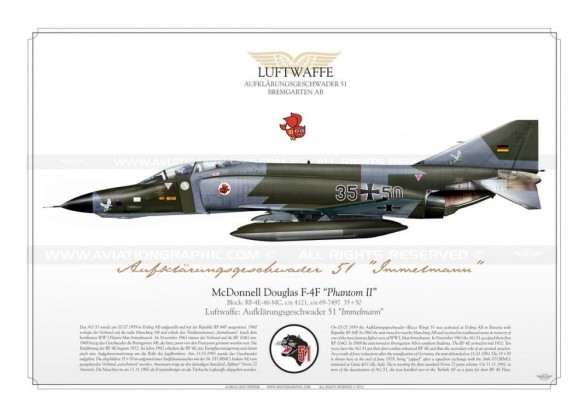West Germany ordered 150 RF-4Es and 175 F-4Fs, a modified F-4E with part-manufacture of the airframes and license-building of the J79-GE-17A engines undertaken by German firms. All these countries invested heavily in the F-4E, and it has been the subject of numerous update programs to extract the longest possible service life from each airframe.
German Phantom operations began with the RF-4E when AKG (Aufklarungsgeschwader) 51 “Immelmann” received its first aircraft in January 1971, followed by AKG52 in September 1971. Initial training began at St Louis and Shaw AFB in 1970, and an element of ground-attack instruction was added in 1988 when the aircraft were given a 5,000lb ordnance-carrying capability. Low-altitude training extended to Goose Bay, Canada from July 1980. Both units disbanded between 1993 and 1994 following the collapse of the Warsaw Pact.
This was basically an F-4E with an RF-4C reconnaissance nose, slatted stabilator, and “hard” wing. In May 1968 Germany ordered 88 RF-4Es as RF-104G Starfighter replacements, with USAF serials 69-7448 to 69-7535 and Luftwaffe codes 35+01 to 35+88. They were upgraded from 1979 to add 5,000lb of conventional ordnance to their recce capability, and an AN/APD-11 SLAR could be carried in a centerline pod instead of the internal SLAR. Datalink and film cassette ejection were carried over from the RF-4C, and AN/ ALE-chaff dispensers were attached to the wing pylons. Israel ordered six RF-4E-45-MCs in July 1968, specifying secondary tactical weapons capability including inboard MAU-12 pylons for AIM-9 Sidewinders or SUU-23 gunpods and air-to-ground ordnance. RF-4Es arrived from February 1971, supplemented by four F-4Es locally modified to carry a downward-pointing KS-87 camera instead of the internal gun. Israel’s RF-4Es often used their AN/ APQ-99 radar’s ground-mapping facility for low-altitude penetration flights. Camera equipment on their standard RF-4Es comprised KS-87, KA-116, and Zeiss RMK-A 15/23 units. Turkish RF-4Es also used the KS-87 but with KA-56 vertical low-altitude panoramic cameras and Elbit-Elop video cameras in the nose. They could use the G-139 LOROP pod and their rear cockpits were updated with a multi-function display (MFD) unit. Japan received 14 St Louis-built RF-4Es, lacking only standard RHAW systems, between November 1974 and June 1975.
